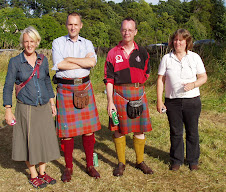A Potpourri, today
Please watch this, from Tamar’s comment yesterday – you must watch with the sound on. I wondered, as I did so, whether it had been made in Scotland, but the cast list at the end made it clear that it’s Welsh. Apart from all other considerations, I always enjoy watching dogs work, because they enjoy it so much themselves, and are so good at it.
I’ve reached the middle of row 18 of the 13th repeat of the Princess centre. I have decided to put four rows of garter stitch beneath my signature box – that should prevent its merging into the Princess pattern, and will balance the four plain rows which are to be knit across the entire centre at the end. So all I have to do is reach row 23. I should easily achieve that before the weekend – during which the prime task will be winding and swatching for the Adult Surprise sweater.
The Historic Knit Yahoo group has taken to being rude about Rutt, of all things. I really should post there, but I am afraid they would tear me limb from limb. I am sure there are defects in his book; it would be a rare book that lacked them. But he is the only writer in English to have attempted a history of handknitting, and he made a pretty good fist of it.
It has been suggested over there that Mary Thomas’ Knitting Book would qualify, if she had been allowed to publish her sources. Rubbish, say I. Her book is an invaluable resource, but it’s not a scholarly history and couldn’t be turned into one. For one thing, she has a lofty disdain for “peasant shape” (dropped shoulders, essentially) which would make it difficult for her to treat with sympathy a number of important knitting traditions. For another, she is far too authoritarian: this is the way it’s done; shut up and listen. For a third, she’s credulous. She lists, for instance, what she was told are the 10 authentic Shetland lace patterns. Alice Korach mentions the list sceptically in an article in Threads in 1987 – since Sharon Miller started publishing, no more has been heard of it.
It is hard to detach oneself mentally from those awful drawings, but I think my criticisms can stand on their own.
The Historic Knitters fault Rutt for being a bishop, and an Englishman (as if Mary Thomas weren’t flesh-creepingly English). But all of us have to start from somewhere.
When Galina's book came out, I thought I hadn't heard of Orenburg knitting. So I looked it up in Rutt, and there it was. And so I have found, through the years: whatever his faults, he tried to cover the subject, and largely succeeded. Subsequent historians can work from there.
I am going to have lunch with Helen Chronic-Knitting-Syndrome today; then we’re going on to John Lewis’ yarn department. What excitement! It should provide some knitterly news for tomorrow.
Subscribe to:
Post Comments (Atom)



No Jean and Helen-spotting today--I am spending the day at King's Buildings, at the other end of town.
ReplyDeleteThank you so much for your support for Richard Rutt! I'm with you on that.
ReplyDeleteI also don't have a lot of time for Mary Thomas's work - I read it and feel like a rebellious schoolgirl.
By the way, Richard Rutt was made a Cornish Bard (for his bishoply work) at the same time as my Mother was. Just a little claim to fame.
I confess I'm not much of a fan of Rutt either, but he's just about the only game in town. I find him rather Anglo-Centric (okay, a lot), but other than some mutterings on my blog when the topic of history books comes up, I've avoided shrieking in public about it.
ReplyDeleteThe real point is, someone ELSE needs to write a NEW book on the history of knitting, preferably with all sources available. And after ransacking the museums of the world for new sources.
In defense of Hknit, I mention the defenses of Rutt that also were posted. The worst rants were on websites that were merely referred to. Rutt's work was and is extremely valuable; if it weren't, we wouldn't bother to criticize the minor flaws. I wish him well and wish he had been able to go ahead with the once-proposed revision of his monumental work. Before Rutt, Mary Thomas's 1938 work was the best available attempt at a general knitting overview for 49 years. Maybe I like her book because I, too, dislike dropped shoulders.
ReplyDeleteHaving read both Mary Thomas and Bishop Rutt's works, I find them good resources. Yes, there are flaws in both writer's books but they still provide information that I have found valuable. They have also provided the spark for me to do research on my own for statements and opinions that I didn't agree with or find credible. But there's no reason to trash them completely for their mistakes. Accept the good, reject the bad. - Joe-in Wyoming
ReplyDelete